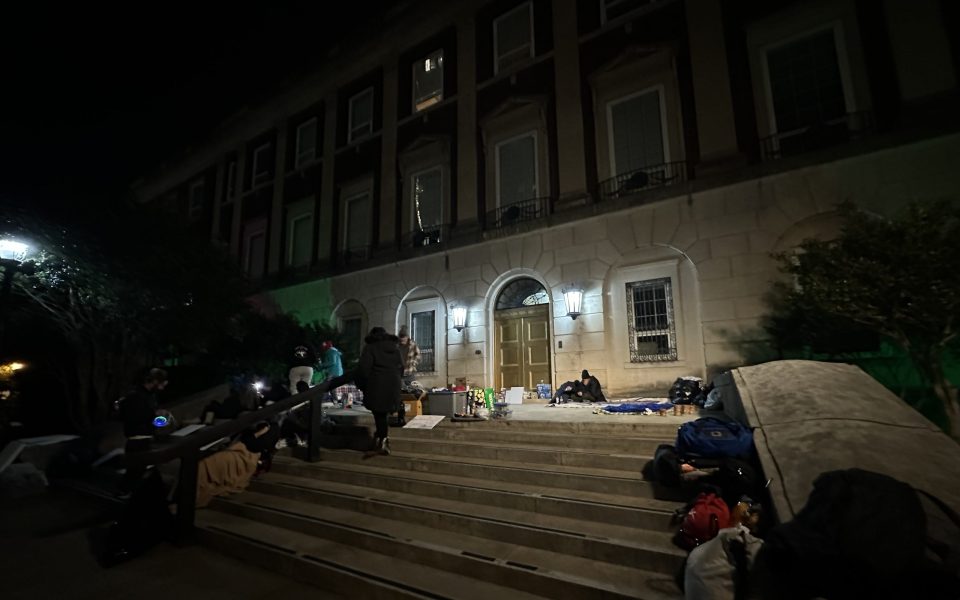Featured photo: Unhoused residents sleep on the steps of Winston-Salem’s city hall on Feb. 8 (photo by Gale Melcher).
Homelessness is growing in Winston-Salem.
Even city staff members are facing it, the city’s Home Program Manager Shereka Floyd told councilmembers on Monday.
And despite the climbing numbers, resources that are meant to help those who are unhoused are inefficiently dispersed, according to community activists, and stigma against the unhoused community is in full force.
According to city data, there are currently an estimated 270 encampments in Winston-Salem; preliminary numbers for Forsyth County’s annual Point-In-Time count noted that there were a total of 487 people without housing. Still, those numbers change daily, from people being forced out of areas or moving to access more resources.
Encampment numbers range from a high of 69 in the Northeast Ward to two in the West Ward; these dwellings are heavily concentrated in the center of the city and between the North and Northeast Wards.
A breakdown of the Point-In-Time count, which attempts to identify the number of unhoused people in the county through a volunteer-led effort every year, shows that there were 125 unsheltered people, an uptick from last year’s 87. Volunteers also counted 362 people in emergency shelters. Last year they counted 282.
Floyd also reported that people are spending more days on the streets. In 2018, people spent an average of 78 days unhoused; in 2023, that jumped to 103. People have had less success obtaining permanent housing, too. In 2018, 32 percent of people exited CoC programs into permanent housing. Now it’s 20 percent.
But activists like Arnita Miles who work with the unhoused on a daily basis say that PIT count numbers are inaccurate, and city staff members like Floyd acknowledge that PIT counts are supposed to represent a “small snapshot of homelessness in a community.”
As previously reported by TCB, volunteers came across encampments this year that were clearly inhabited, but their occupants either weren’t home or didn’t respond to calls from volunteers. Greensboro’s Housing and Neighborhood Development Director Michelle Kennedy has stated that PIT counts can be “notoriously” undercounted.
“You have to look at the time the PIT count occurs,” Miles said. “9 p.m.-4 a.m. If I come to your home at 2:30 in the morning as a volunteer for the PIT count, are you gonna let me in?”
Even the National Law Center on Homelessness and Poverty has stated that the numbers don’t represent the full picture.
“The annual PIT counts often mobilize large numbers of volunteers and serve to educate communities about homelessness. However, despite all the community effort and goodwill that goes into them, and due to no fault of the professionals and volunteers who carry them out, the counts are severely flawed,” a 2017 organizational paper states.
And that undercounting and lack of visibility adds to the stigma, and violence, that those who are unhoused continue to face.
During the PIT count on Jan. 31, TCB met an individual who had experienced horrors simply for existing as an unhoused person. Someone once found his encampment, doused it in gasoline and set it on fire. This happened at night, and he was lucky he wasn’t there, or worse yet, sleeping.
“How can people be so cruel?” a PIT count volunteer said.
As far as how the city handles encampments, once a location is reported via CityLink, WSPD or Neighborhood Services, code enforcement visits the encampment and cites it for “trash violations.” The city’s BEAR Team, which serves as an alternative to police, along with street outreach teams, will visit the encampment within 72 hours to offer supportive services and emergency housing options. No trespassing signs are posted if it’s city or state-owned property, and street outreach and BEAR Team members return to notify the residents that the site will be cleaned up. WSPD and code enforcement are present on the day of clean-up and additional services and referrals are provided to residents.
Councilmember Robert C. Clark, who represents the West Ward made comments during Monday’s meeting that reflect some of the stigma unhoused people still face. “You’re homeless, we get you in a permanent shelter, wraparound services, hopefully you get a job and move on,” said Clark, who worked as an outside director of Triad Business Bank and is the president and owner of Leesona Industries headquartered in Burlington.
Then Clark asked Floyd, “How many of those folks are we able to do that with?”
Clark said that he’s volunteered for decades with places like Samaritan Ministries and that he’s “always questioned what percent of homeless people are truly employable.”
“And by that I mean you’ve got to get up, get dressed, go to work, come home, whatever,” he said, adding, “so many of them that I have dealt with…I don’t know if they could do that: Get up every day, go to work and come back. Even with wraparound services.”
“I’d be curious as to what y’all have learned,” Clark added, asking, “What is our true success rate?”
Floyd responded, saying that while they do have a “large chronically homeless population,” she knows at least four city employees who are facing homelessness. The minimum wage for Winston-Salem’s city employees is $15.45, while neighboring Greensboro’s is $18, meaning that a 40-hour work week can earn many Winston-Salem city employees just a little over $32,000 annually — and that’s before taxes. The Economic Policy Institute family budget calculator estimates the amount needed to support a “modest yet adequate standard of living.” In Winston-Salem, that’s $41,889 for one person.

Where’s the money going to combat homelessness?
During Monday’s meeting Floyd showed councilmembers some city properties that they could potentially turn into permanent supportive housing and affordable housing. She pointed to micro-shelters that cost $9,000 apiece and take 30-45 minutes to construct that the city could use as well. City leaders will be able to tour these micro-shelters in March, Floyd said.
In Greensboro, a similar program called the Doorway Project debuted in December 2022. Unhoused residents temporarily live in pop-up shelters called Pallets; this year residents moved in in November and will stay until the end of March.
Winston-Salem applies for federal and state funding on behalf of the Continuum of Care: a collaboration between nonprofit agencies, the city and county, local healthcare providers and other homeless service agencies. Then they work with the CoC to disburse the money to community agencies.
But Miles feels that the CoC is “broken” and has problems with how they allocate their funding.
According to city records, the CoC gets around $2.9 million from HUD, but these funds can only be used for things like rapid rehousing and permanent supportive housing. They can’t be used for emergency shelter services.
The city also receives more than $500,000 in state and federal grants, and around 60 percent of that money goes toward shelter services, emergency shelter and street outreach programs. The remainder of the funds go towards items like data entry, permanent supportive housing, case managers, housing vouchers, rapid rehousing — including cases related to domestic violence — and more. During the month of January, street outreach services connected with 276 people experiencing homelessness.
Miles noted that a lot of this funding comes from state and federal grants, and thinks that the city should be spending more of their own money to help the homeless.
Miles is also worried about the lack of bed space for people seeking emergency shelter.
While there are multiple shelters in Forsyth County, the only White Flag shelter is run by City with Dwellings. It can support up to 40 people and it only opens when the temperature dips below 32 degrees, or 38 with precipitation. The Salvation Army states that they operate the only emergency shelter for families.
“Where are the other people supposed to sleep and go if they need emergency shelter?” Miles asked.
Activist Lisa Uber hits city streets daily. She sees people “making beds on the pavement,” but says that she has yet to come across street outreach teams.
Uber said that she recently picked up a man who was hypothermic and mumbling incoherently.
“He was not on drugs, he was freezing,” Uber said. “He had nowhere to go; he was turned away from every place he went to.”
After an hour in her warm car, “he could speak, he could talk,” Uber said.
“Half the time they don’t have a blanket” or “anything to keep them warm,” so Uber gives them blankets and supplies.
“We find the people that aren’t lucky enough to get in those shelters,” she said.
All CityBeat reporting content is made possible by a grant from the NC Local News Lab Fund, available to republish for free by any news outlet who cares to use it. Learn More ↗
Republish this storyJoin the First Amendment Society, a membership that goes directly to funding TCB‘s newsroom.
We believe that reporting can save the world.
The TCB First Amendment Society recognizes the vital role of a free, unfettered press with a bundling of local experiences designed to build community, and unique engagements with our newsroom that will help you understand, and shape, local journalism’s critical role in uplifting the people in our cities.
All revenue goes directly into the newsroom as reporters’ salaries and freelance commissions.


Leave a Reply